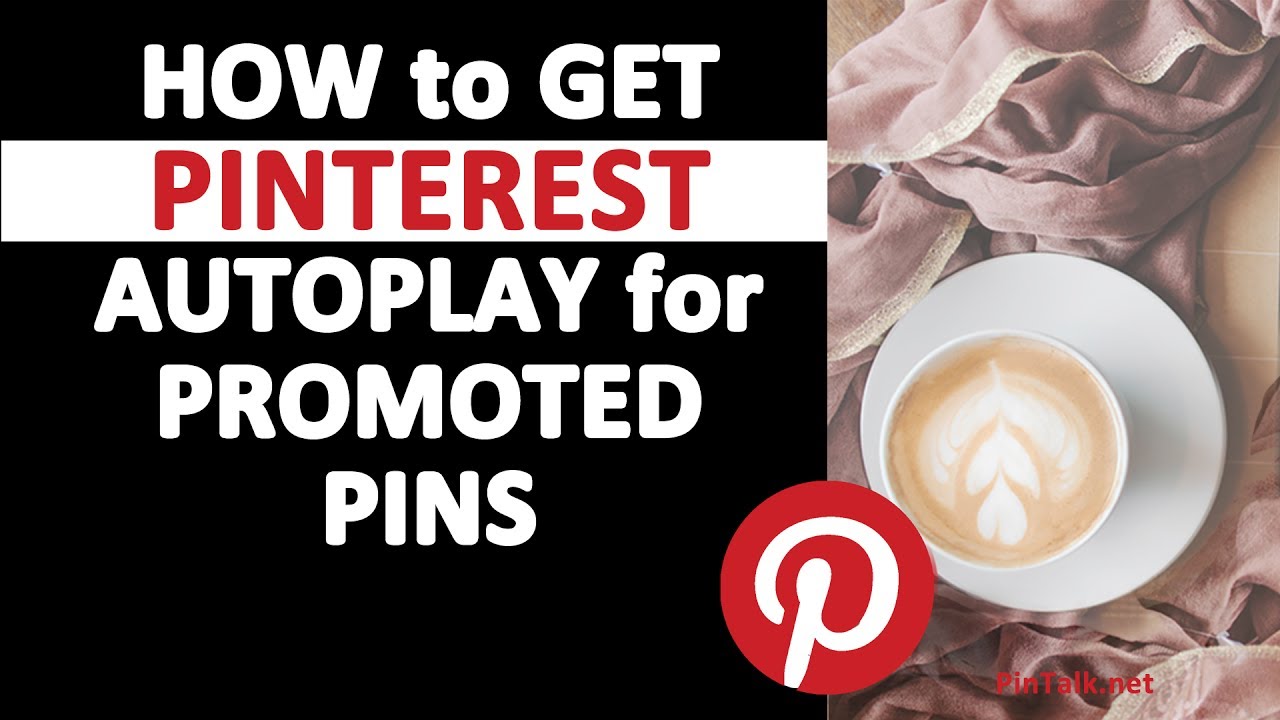Goodbye, Marketing Funnel! Hello, Customer Flywheel!
At the 2018 Inbound Marketing Conference, Brian Halligan, CEO at HubSpot broke the big news:
HubSpot was closing the door on the company’s sales and marketing funnel and adopting a new model – the Customer Flywheel.
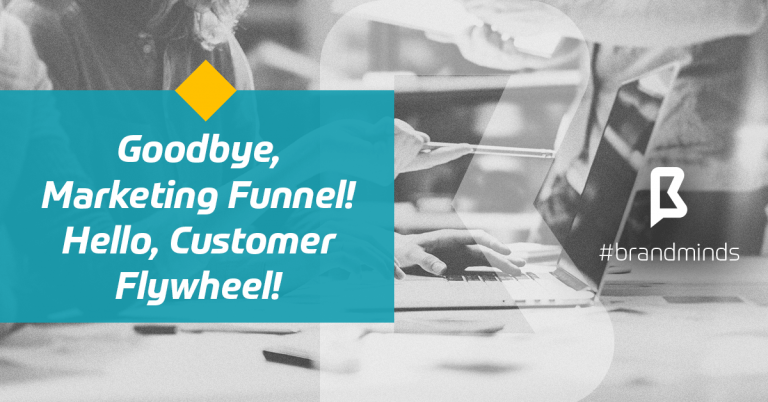
A declared supporter of models, Brian said that for the past 10 years, the funnel worked great for HubSpot. Sales and marketing were feeding the funnel with prospects and leading them towards the top with valuable content and sales conversations. Attract, convince, delight.
It all changed two years earlier when HubSpot noticed that their customers were being convinced to buy HubSpot products by an acquaintance or friend who was already a HubSpot customer. As Brian put it:
The loudest voice in their customers’ head were not sales and marketing any longer but word of mouth.
A Sign of The Times – Shift of Trust from Brand to Customers
Drawing on this insight, Brian recommends brands do as follows:
- Trust your customers to convert your prospects into new customers;
- Acknowledge that word of mouth is your brand’s most powerful channel;
- Shift your mindset from the customer being an output to the customer being an input.
How can brands do that? By adopting the Customer Flywheel.
What is a Flywheel?
A flywheel is a rotating disk used as a storage device for kinetic energy and it pretty much looks like this.
James Watt contributed to the development of the flywheel in the steam engine in the 1800s.
His flywheel was foundational to the Industrial Revolution because it was highly efficient at capturing, storing, and releasing energy.
Will the Customer Flywheel revolutionize business growth in 2019?
HubSpot seams to think so.
Flywheels represent a circular process where customers feed growth.
Jon Dick via hubspot.com
The rules are changing – From Sales & Marketing Funnel to the Customer Flywheel
It’s 2019. What do you need to build a great company?
Up until now, the answer was: a product 10x better than your competition.
Brian believes the answer has changed: the secret to build a great company is to provide a customer experience 10x lighter than the competition.
It’s not what you sell; it’s how you sell.
Brian Halligan, CEO@HubSpot
The Customer Flywheel – The Best Way to Find New Customers
Brian Halligan says the funnel is flawed because it fails to capture momentum.
According to this model, the company puts all its efforts into pushing them through all the stages of the funnel only to close the door behind them once they become customers. It’s like when you had a good time with your date, but you don’t call the next week to repeat the experience. It’s a wasted opportunity!
We all know that it’s harder and more expensive to attract a new customer. Why not make the most of your current customers? Instead of giving them the cold shoulder, start a relationship and turn them into brand advocates. The work is not done once your sales rep converted the prospect to a customer. The work has just begun!
The funnel can’t conceive of customers buying from you more than once, so the momentum you build acquiring customers via the funnel just falls away.
Marketingland.com
The Customer Flywheel leverages the enthusiasm of existing customers and turns it into a driving force for attracting new customers. In his speech, Brian said HubSpot has applied all its energy and force to sales and marketing like all brands have in the past a hundred years. Beginning with 2018, the company has shifted its centre of gravity away from the funnel and applied more force towards delighting their existing customers.
Funnels produce customers, but don’t consider how those customers can help a business grow.
James Gilbert via Marketingmag.com.au
What makes the Customer Flywheel spin?
Force and friction are the two dynamics that directly influence the spin of the flywheel.
What makes the flywheel spin faster and faster? Increased force and reduced friction. The more force with less friction applies to the flywheel, the faster it spins. Once the flywheel gains momentum, it can spin forever with little effort from the company.
Once your flywheel is spinning, momentum comes from retaining customers and transforming them into promoters who will advocate for your brand and even bring you knew business.
Jon Dick via hubspot.com
Here’s what brands need to do to keep their Customer Flywheels spinning according to HubSpot:
1. Increase speed
To make your flywheel spin fast, your company needs to align its sales and marketing. Misalignment of sales and marketing departments leads to flywheel slowing down. If you want to increase the speed of your flywheel, improve your conversion rates, delight customers at scale and address the issues that cause your company to churn customers.
2. Reduce friction
Traditional organisation of the company is the source of friction in a flywheel model. Silos, handoffs, and specialization all create friction. Find the inefficiencies where your customers are losing momentum and make them better.
3. Heaviness
Work towards getting a heavy flywheel. Heaviness is reached by acquiring more and more customers. A heavier flywheel means it is producing more energy when spun. It’s physics! The more your customer count increases, the more growth is your flywheel producing. You can generate even more momentum by getting your customers to adopt more of your products.
Three Benefits of the Customer Flywheel according to Eric Baum of bluleadz.com:
- It’s self-perpetuating;
- It requires alignment;
- It’s relationship focused.
Why is the Customer Flywheel working so well?
The Customer Flywheel is the solution to the challenges the sales and marketing people are experiencing today:
- decrease of brand trust;
- increase of word-of-mouth;
- decreased effectiveness of marketing campaigns which focus on running too many sales activation-based campaigns to the detriment of brand building activities.
Learn more: Your Marketing Campaigns Are Less Effective
[bctt tweet=”In 2019 successful brands will turn customers into brand advocates and morph into a customer-centric company.” username=”brand_minds”]
Main takeaways if you are committed to implementing the Customer Flywheel:
- Examine what forces your company needs to apply to make the flywheel spin – activities, programs etc;
- Identify the frictions and work towards reducing them as much as possible;
- Gain new customers by turning your current customers into brand advocates;
- Find new ways to maximize delight;
- Set alignment between departments as your 2019 organisation goal;
- Begin the process by which your company will embrace customer centricity in 2019.
Join the Conversation
We’d love to hear what you have to say.
Get in touch with us on Facebook and Twitter.
sources:
https://hbr.org/2018/11/replacing-the-sales-funnel-with-the-sales-flywheel
https://blog.hubspot.com/marketing/our-flywheel
https://www.bluleadz.com/blog/funnel-vs.-flywheel
https://www.rakacreative.com/blog/marketing-strategy/how-and-why-to-convert-your-funnel-to-a-flywheel/
https://marketingland.com/from-funnel-to-flywheel-249765
https://www.marketingmag.com.au/hubs-c/opinion-gilbert-funnel-flywheel/
7 Smart Ways to Collect Customer Feedback Online
Customer feedback is the best way to improve your product.
If asked, your customers will tell you what they like and what they don’t like and how they use your product (which sometimes you never thought about). If you take a step back and look at the bigger picture, your customers feedback can turn into valuable insights which may point to future business development directions.
Pictures are worth a thousand words so keep reading because we will delight you with illustrative examples.
Here are 7 smart ways to collect customer feedback online:
1. Survey forms
Whether you use Google forms, JotForm or TypeForm, the times of customers filling in boring feedback forms are long gone.
Now companies and organizations have a plethora of services which help them collect customer feedback while providing a pleasant experience.
The way your company is collecting feedback is as important as any other form of communication. It is an opportunity to show your customer that you care about their insights and you also care about how you are speaking to them.
Google Forms is one of the widely used online service to collect customer feedback:
- You can use your own photo or logo;
- It is intuitive – it will pick just the right colors to complete your own unique form;
- It provides you with a set of curated themes to set the tone;
- You can add images and YouTube videos to keep your customer engaged;
- There are multiple question options;
- Your forms have responsive formats;
- Responses are automatically organized;
- You can add collaborators.
JotForm is another provider of great survey forms:
- The collected information is sent directly to your integrated accounts and email inbox;
- It is integrated with MailChimp, Dropbox, Google drive etc;
- Its forms are specifically designed for various industries: marketing, healthcare, agencies, designers etc;
- You can add payment processing to your form (PayPal is one of the supported payment platforms);
- You can choose from a wide range of free form templates.
TypeForm is also a provider of survey forms with a twist:
- It puts the spotlight on conversational;
- It offers templates for every stage of the customer journey;
- It has a great interface that keeps people engaged;
- Make your questions pop with gifs, images, videos;
- Easy embedding into your website.
2. Instagram Story poll
In october 2017, Instagram introduced the interactive poll stickers that allow companies to ask questions and see results from followers as they vote.
Given there are 400 million daily active Stories users worldwide (statista.com), the poll sticker is a great and fun way to collect feedback from your customers.

image source: curalate.com
3. Facebook poll feature
Facebook is another social media platform which helps companies collect audience data.
By using polls, your company can increase its organic reach, attract attention, build brand awareness, build a relationship with your audience and increase engagement.
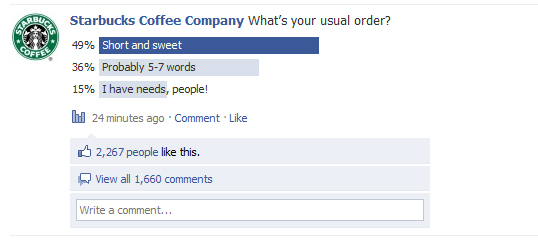
image source: entrepidinc.com
4. Surveys on your website
You have been working hard to attract visitors to your website.
Why not make the best of their visit and ask them questions using a website-hosted survey?
SurveyMonkey is one of the service you can use to host your surveys on your website.
Here are 3 types of surveys provided by SurveyMonkey:
- Pop up in a window – it provides a direct method of getting in front of your users;
- Website embedded – use it when you don’t want to interrupt your website visitors experience;
- Pop up invitation – it is correlated with the embedded survey because it pops up inviting your website visitor to take a survey.
Find out how Hootsuite used Qualaroo to discover valuable insights related to their landing page visitors behaviours.
5. Social media listening
Whether they are happy about your product or angry about your service, your customers turn to social media to tell everyone about it.
According to a Marketing Land study, 71 percent of all complaints on social media are posted on Facebook.
They may not mention your brand name so if you are not using a social media listening tool, you may miss out on a great opportunity to collect feedback.
Here are 7 ways you can grow your business using social media listening tools.
6. Chatbots
Chatbots are one of the most flexible and efficient automation tools available right now.
They can be programmed to achieve various objectives and meet company needs through conversation. They can live on company’s website, inside your company’s app or Messenger.
From increasing sales to qualifying leads, there is little chatbots cannot do. Using chatbots instead of the good old survey forms is a step up in the right direction. Chatbots can actually support your company to create a more engaging, fun and ultimately human customer experience.
Discover more about the benefits of chatbots in our article How to gain more leads with conversational marketing.

image source: chatbotslife.com
7. Survey inside Messenger
In a recent study, Survey Monkey found that 9 out of 10 people who took a survey on Messenger enjoyed their experience and would take a survey again in the app.
There are over 1 billion people messaging Facebook pages every month to ask questions so Messenger is definitely a great medium to talk to your customers and collect their feedback.

Learn about conducting surveys inside Messenger here.
Tips on how to craft your questions
Whatever tool you are using to collect customer feedback, here are our tips on how to craft your survey questions:
- Write your questions with your customer in mind what’s in it for them;
- Be specific and on point – asking vague questions will only get you vague answers;
- Be creative;
- If your survey is long-form, give them an incentive to complete your survey;
- Segment your customers and ask them laser-focused questions;
- Tell them they belong to a selected few;
- Get their attention with humour;
- Use a problem you have already identified as a starting point.
Here are a few examples:
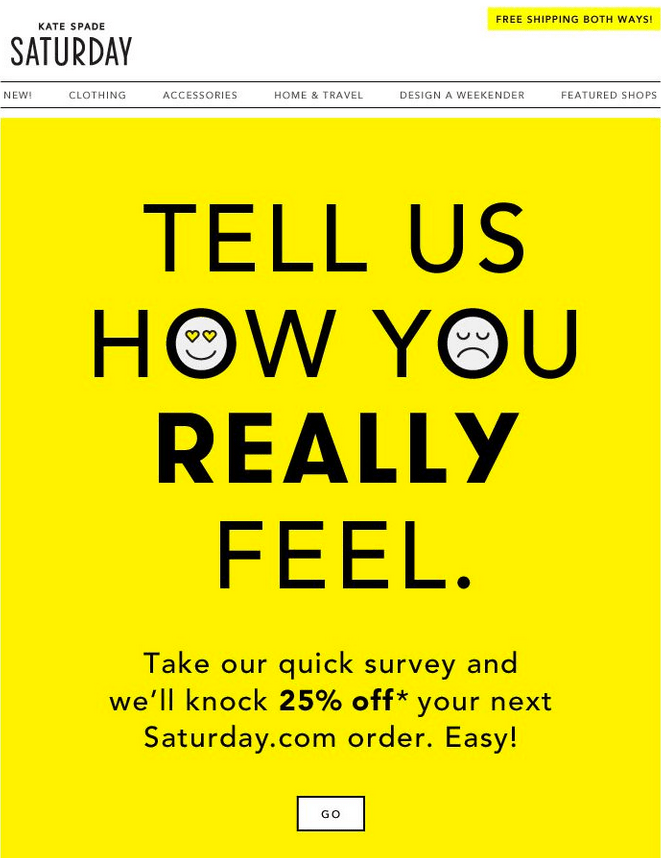
image source: marketingland.com
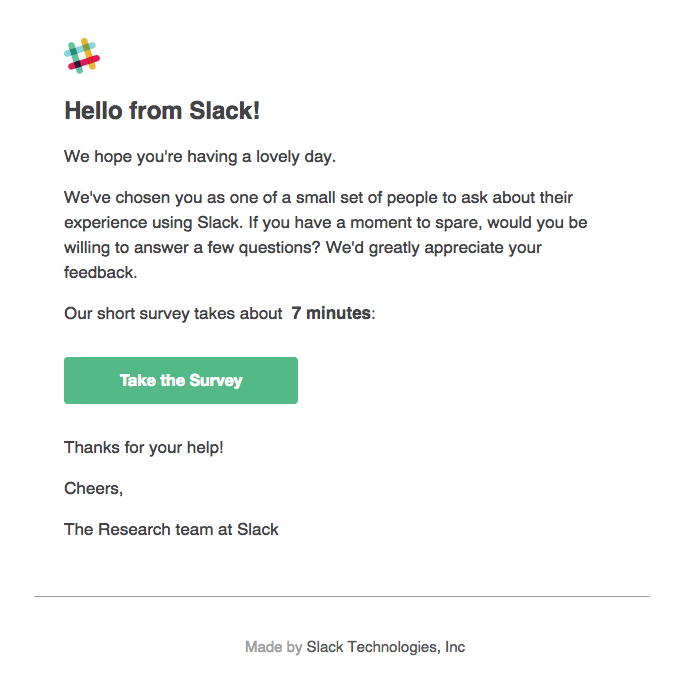
image source: reallygoodemails.com
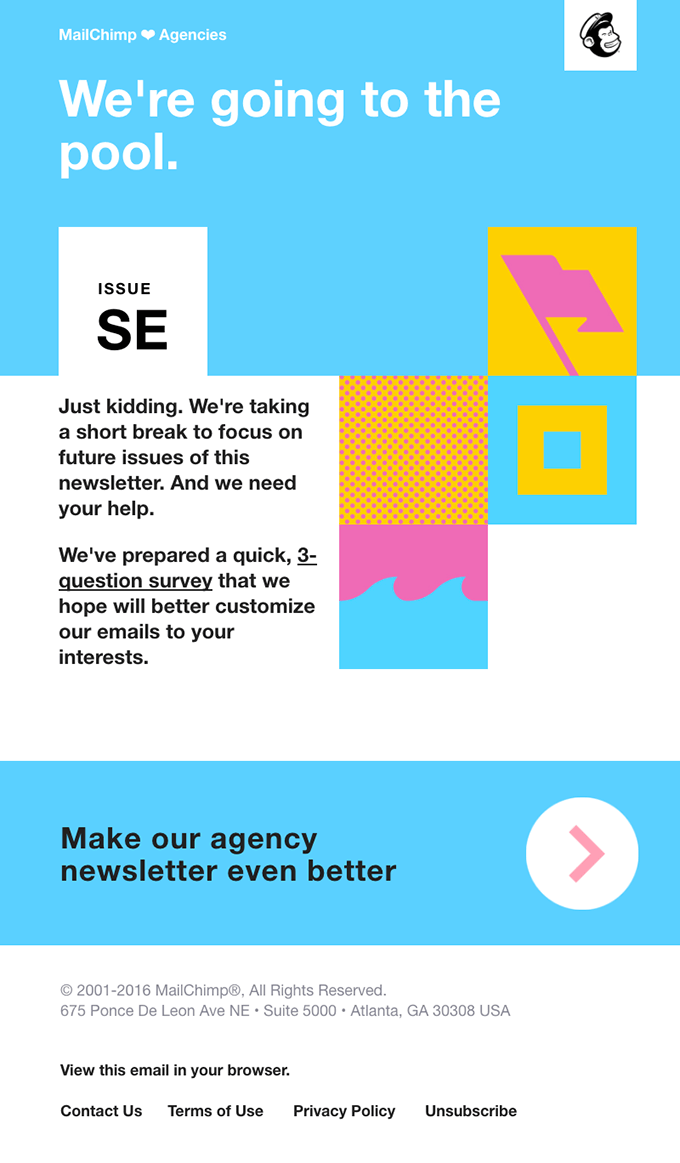
image source: reallygoodemails.com

image source: essenceofemail.com
5 pieces of advice for entrepreneurs in 2018, the international PR agency point of view
PR has become indispensable for companies nowadays, evolving from “simple” media relations activities to strategy,consultancy and more and more diverse services. Moreover, it’s obvious that it needs to be part of the whole communication process and in close relationship with marketing and sales, being one of the business’ best driving forces. Raluca Ene, Managing Director Chapter 4 Romania offers 5 important pieces of advice for entrepreneurs in 2018, to take home about how to tell the world about your entrepreneurial endeavor:

Know your WHY – there is nothing more important for a successful communication effort than being crystal clear not only on what you do and for whom, but why you’re doing it. The single most important thing that would transmit directly to your potential customers is your motivation and drive.
Know your customer inside out, especially where your customer takes his/her information from – build personas, as they should do the trick and reveal the channels your customers use (media, social media, blogs, events etc.). Gather information about the respective channels. Don’t be afraid of words such as virtual reality or artificial intelligence – see what’s there, don’t dismiss anything by default.
Be honest about the resources you are ready to spend on communication – I know, it’s rather annoying to learn something you know is necessary for the growth of your business, but not your cup of tea at all. Nevertheless, if you want to make your business work, you have to be efficient, and that should go first.
If you are just starting up or in the first stage of developing the business, maybe it would be better to consider choosing a seasoned communication consultant, pay a one-time fee for a professional advice and guidance and assume the implementation yourself rather than paying an internal specialist or an agency retainer. Go to marketing & communication events for entrepreneurs, there are quite a few available these days, and some of them are quite good. Once you start having a steady profit, hiring a professional team would definitely free your time to dedicate to your business.
Invest wisely – make your dollar count and choose to invest in the channel with the most exposure to your core target. Take into consideration building your own space for telling your story (e.g. website, blog, YouTube channel) before deciding where to promote it. Specialists might give you different kinds of advice – ask for as many arguments as possible and listen carefully, but make your own decision. Your entrepreneurial guts matter more than you think, listen to it.
You are the best ambassador of your business, use yourself! Even the shiest of entrepreneurs lighten up and become energetic and passionate when it comes to their own creation, therefore put yourself to good use and go out there: talk about your business, go to events, ask questions (especially to more seasoned entrepreneurs that went successfully through the phase you are now), be there. It will pay off, and then some.
No product or service would sell without people finding out about their existence first (and yes, word of mouth is a communication channel as well J), so why not embrace it and make room in your agenda for communication – there are plenty of resources to inspire and help you around.
Biggest digital trends in 2018
For the last five years, the agency Ogilvy creates an annual report which aims to spot the key trends in digital and social media marketing that are likely to be important in the coming year. The report contains the agency’s predictions from the previous year and every trend includes actual, actionable recommendations for brands. In 2018, for its fifth report, Ogilvy included also a section that reflects on five years of trends, and looks at the big stories the agency’s representatives have seen play out since they started writing the report.
The report can be seen here and it features five big trends to watch for in 2018: Augmented Reality, The End of Typing, The Tragedy of the Commons in Influencer Marketing,The Amazon Awakening and Seriously Serious.
In our turn, we’ve talked with two specialists on the Romanian digital industry and we found out their predictions and thoughts.

Flavian Cristea, Digital Strategist Grapefruit:
– What do you believe will be the biggest digital trends of 2018?
The biggest digital benefits for customers will come from conversational interfaces and specialized artificial intelligence. These technologies enable customers to use natural language to interact with companies and their assets. We will be seeing more and more cases of making a bank deposit by messaging a chatbot or ordering products from the internet by using digital assistants such as Google Home or Alexa.
We are seeing specialized artificial intelligence and mixed reality as being the main drivers of digital change inside companies. These technologies are used to strengthen the capabilities of the employees, getting more out of the same individuals. It’s a complementary relationship, where the technological aspects fill in for the weaknesses of the humans and the other way around. Blockchain is also a technology that migrated from cryptocurrency to other businesses such as banking and trading, opening new ways of communicating, controlling and tracking information.
– What are they influenced by and why?
The user wants the barrier between the digital and reality to disappear. This desire appears out of the wish of the individuals to interact in a more natural way with everything they use. It’s easier to ask “How much money do I have in my account?” than to go inside a banking application and check your account. It’s also more natural to interact with objects with your hands than with your mouse.
Another obvious influencer is the progress we have achieved in the fields of artificial intelligence and virtual reality. The fact that these technologies are also researched and developed in an open way is a great contribution because everybody can experiment and share what they learned in the process.
– What is Grapefruit advising its clients this year?
We advise our customers to find contexts inside their company to experiment with each technology mentioned above. It does not have to be a big project. Just big enough that, if successful, it can become a pilot project for a bigger digital change.

Andrei Balan, Head of Strategy MRM McCann
– What do you believe will be the biggest digital trends of 2018?
Two things I’d look for in the following year are the access and sharing economy spreading to different aspects of our lives and micro targeted content.
– What are they influenced by and why?
Let’s start with the access and sharing economy. The basic idea here is the digital environment contributes to a steep increase in the number and intensity of desires. The overall digital connectedness lets us know about products and services virtually instantaneously. It also provides us with unprecedented insight into other people’s curated live, so we get to know what everyone has and does. These are both vectors for wanting more things more intensely. Moreover, things like retargeting contribute to turning these desires into quasi-obsessions. But what happens when the number and intensity of desires increases much faster than the financial means to support them? It builds up to phenomena such as the access economy, the sharing economy and then the democratization of all sorts of things and services. For example, why own music when you can just rent and listen to it? Also, people now get to travel to more distant places because Airbnb allows them to cut accommodation costs and invest more in transport. This is a simple example of touristic democratization enabled by the sharing economy.
Now let’s talk about micro targeted content. As it is becoming clearer content is winning the battle with online advertising, we’re starting to look more into what, how and why it works. Using real people, famous or not, to provide credibility to content is already something everybody does. The next base is micro targeting, or micro community-tailored content. This means building certain variations into a marketing campaign that make it more relevant for each segment of the public. And then using media targeting to reach each community with the proper variation.
– What is MRM advising its clients this year?
Our advice? Have no fear in riding the trends. I know countless people who regret not investing early in cryptocurrencies. I myself am one of them. The same thing goes with all trends: ride them early enough to be among the ones who profit most.
All you need to know about autoplay video in Pinterest ads
Pinterest’s Promoted Video ad units, introduced on August 2016, went on auto-play in 2017. The new type of Promoted Video begins playing as soon as users scroll across it in their feeds, and these ad units will also auto-play in Pinterest’s search results.
“Pinterest has had to make the argument to advertisers that its 175 million users behave differently on Pinterest when compared to Facebook and Google, or even Twitter and Snap. Pinterest users come to the site and dig through products and recipes, among other things, for ideas. They then search deeper into topics, save them, and then eventually in theory acting on them later — either by cooking the dish or buying a product. Pinterest’s pitch is that unlike Facebook and Google, which can offer a compelling ad product for one point of that part of a customer’s buying life, it can offer products across the whole timeline,” wrote TechCrunch.
Moreover, said AdWeek, “Pinterest announced that Nielsen Mobile Digital Ad Ratings will measure audience reach of campaigns using Promoted Video with auto-play, while Moat will provide data on viewability, or how much of the videos were in view. They join existing measurement partners Millward Brown for brand lift and Oracle Data Cloud to measure the impact on offline sales”.
According to Pinterest’s Business page, Promoted Video delivers dramatic results, including lifts in brand awareness and favorability. Plus, using Promoted Video to show your ideas in action produces big gains in intent to act. “With 80% of Pinners using mobile devices to access our platform, it pays to use Promoted Videos, a naturally engaging format that can quickly capture the interest of this on-the-move audience,” concludes the post.
Best packaging ideas for 2017
In the very competitive and full of inspiration and imagination year such as 2017, a good product is not enough for it to become a brand and capture the consumer’s attention. Let alone make him/ her choose it from the numerous similar products on the shelf and lead to a future buy. Therefore, a great packaging design, in sink with the product’s qualities, characteristics and what it stands for, will mark the path to a successful rise and growth of a brand.
Here are some of this year’s main packaging design trends and ideas:
1. Back to basics. Simple, bold and clear
source: skinn.be
This year, the trend is better articulated and more compelling to the customer. Minimizing the elements used in a package design can elevate a product… as long as it gets the point across. In our fast-paced world, shoppers don’t always have the time to study each and every product detail. Sticking to the essentials and making sure the buyer will make a more informed decision, a clean-cut design can convey information and make a product shine using simplicity.
According to thedieline.com, the designers understood the purpose of the object and the thought process of their audience. In service of this, they simplified the message and stated it clearly and boldly across the face of the packaging. These designs are text-based and say what they are in no uncertain terms. They realize the value of a simple message in today’s crowded world. The simplicity does not come off as lazy or incomplete but refreshing and honest. This is the manifestation of the idea: clarify not simplify. These designs identified exactly what the customer was searching for and expressed it simply. It comes off as powerful and trustworthy.
source: tapped
2. Putting focus on the custom lettering
Almost every designer loves to get crafty and create some of their artwork by hand. According to Martin Lupus of 99designs.com this thing happens in order to get the organic effect: fluid imperfections—like irregular lines or natural texture fills— that can make a product stand out through warmth and set it apart from digital designs. “This warmth can create an emotional tie to the product, making it feel handmade and wholesome, or communicating a feeling of nostalgia. Either way, for 2017, we are seeing a massive comeback of hand-lettering,” added Lupus.
source: sweetyland
3. Letting geometry rule!
source: thedieline
Hand in hand with the previous trend, this theme is centered around expressing simplicity, approachability, and honesty through patterns and shapes. Circles, triangles, and squares are, as the specialists consider, an attempt to treat the mindset of a weary, overwhelmed consumer. Particularly in industries with over-the-top design, these reduced approaches standout. Familiar shapes, colors, and patterns communicate an awareness of the world and a sensitivity to the consumer.
- Old school with a twist
The past is haunting us, but in a good way, through a “idealization of the past—a longing for simpler times when things were cared for, made by hand, and detail-oriented”, as Grant Wenzlau from dieline.com would say. But these designs are not simply regurgitating old forms and techniques, they are modernizing them and combining them in new ways. “This new take on what is old is refreshing because it selects the best parts of different periods of our history and juxtaposes them. These designers realize the increasing rareness of endangered techniques like calligraphy, letterpress, and foiling. These artisanal practices grow more and more desired each year. In the mind of the consumer, they are increasingly novel and related to greater value. But far from merely being historical, these techniques are being re-imagined in the context of mid-century layouts and applied to a 21st Century, cutting-edge materials”.
source: ACH Vegan Chocolate
source: cocktail kit
Moreover, vintage package design brings back memories for people who lived through the original era and satisfies the curiosity of younger generations eager to explore the past. The key to going vintage is to find a balance.
5. Making the color a focus and priority
Colors evoke emotions and affect purchasing decisions. Because of this, color has always been one of the most important choices in packaging design, presenting in new, exciting ways. Bright colors and vibrant associations are beginning to make a scene on store shelves. More than that the colors and their special use are able to differentiate the packaging and the product at the shelf, making it to stand out and attract the consumer that will always choose exciting over common and boring. Also, it is proven that the consumer will always remember a product that is interesting and has the wow visual factor.
source: Pyramida
source: Resonance
6. Be playful and multi-functional!
In each of us lays a child and we love to be given the opportunity to loose ourselves from time to time. So does the consumer. He appreciates a good, interesting packaging that can be joyful, playful and multi-functional.
source: Monstea
7. Repeating a pattern
source: Helmes Workshop
We learn and remember through patterns, as our brain is built that way. Using well-chosen and beautiful patterns can also elevate a package design from ordinary to ethereal. Although the idea of repetitive shapes might seem simple, the technique can be dynamic and compelling when used correctly. Moreover, as it happens in writing a book or a play or a song, repeating a visual motif that captures the essence of the brand sends a strong message. Whether the pattern is bold or playful, patterning the package can create a strong identity that customers will always remember.
8. Storytelling & narrative
source: Smith & We All Need Works
People love stories and, as previously said, having a story behind everything one does it’s always a plus, giving it authenticity and creativity, at the same time. We seek out and cherish the stories that feel closest to our hearts, therefore the packaging design are starting also to incorporate narrative illustrations, trying to get closer to the consumer’s empathies and emotions. The place where the real sale and conviction start.
9. Putting it in the mail
source: Luxembourg
Internationally, there’s a strong comeback for the print and its values, for going to back to the roots, the life before the online. Coffee shops that are inviting their costumers to stop using the wifi and talk to each other, online magazines that are starting to get their first printed versions, people choosing books over kindles, etc. With faster, more efficient ways to communicate, the joy of receiving a letter via the post, in the real mail, not online, has started to disappear over the years. But there is a new trend that will take people back to that feeling. According to the specialists from 99designs.com, the packaging design is here to save the day with an emerging postal trend.
10. Going eco-friendly
The years to come will be more and more about sustainability. According to packaginginnovation.com, the new trends are about using green padding materials, with biodegradable bubble wrap and recycled paper being perfect eco-friendly alternatives. “One of the leaders in sustainable design, method sells bottles made with recycled ocean plastic. From using more renewable resources to keeping materials recyclable, more consumer brands are integrating eco-friendly design into their business. This is a trend that we hope to see grow with each year because it benefits everyone,” also added and concluded Martin Lupus.
source: Grow With Me




